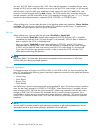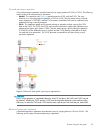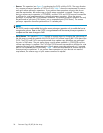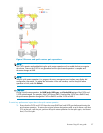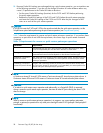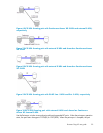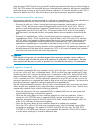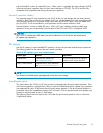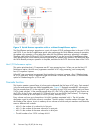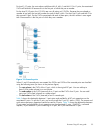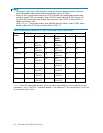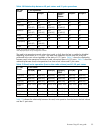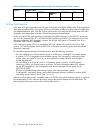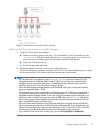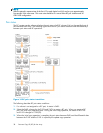
Figure 11 Quick Restore operation with or without Swap&Freeze option
The Quick Restore pairresync operation on a pair with status of PSUS exchanges data in the pair's P-VOL
and S-VOL. If you use the Swap&Freeze option when performing the Quick Restore pairresync operation,
the update copy operation will not take place after the Quick Restore pairresync operation is complete.
Therefore, data on the P-VOL and S-VOL is kept exchanged. If you do not use the Swap&Freeze option
when performing the Quick Restore pairresync operation, the update copy operation will take place after
the Quick Restore pairresync operation is complete, and data on the P-VOL overwrites data on the S-VOL.
Host I/O
Performance option
This opt
ion prioritizes host I/O responses over BC copy processing time. When you use the Host I/O
Perfor
mance option, the disk array suppresses execution of BC copy processing, and consequently
host I/
O responses improve.
When BC copy processing is suppressed, the time taken for copying increases. Also, if ShadowImage
for z/OS pairs exist, host I/O responses might not be faster. In this case, set the Host I/O Performance
option for ShadowImage for z/OS as well.
Cascade function
This function creates a second layer of volume pairs underneath the first layer of BC pairs. Pairs created
in the first and second layer are called cascaded pairs. Figure 12 illustrates cascaded BC volume pairs.
The first cascade layer (L1) is the original BC pair, consisting of one P-VOL (root volume) and up to three
S-VOLs (node volumes). In the second cascade layer (L2), the S-VOLs of the original BC pair function as
the P-VOLs of the L2 pairs, and each L2 P-VOL can have up to two S-VOLs (leaf volumes). This layering
schemecancreateuptoninecopiesofoneBCprimaryvolume(P-VOL).
Every volume can have up to three Mirror Unit (MU) numbers associated with it. The MU number
designates a pair for which the volume is a member. The MU number is not the number of the pair, but
the number of the volume. A pair is made up of two volumes of which each pair member could have the
same or different MU numbers.
• MU=0 is the number of a volume for its first pair.
• MU=1 is the number of the same volume for its next pair.
• MU=2 is the number of the same volume for its third pair.
• The MU number of an S-VOL is always MU=0.
32
Business Copy XP (BC) for the Array



